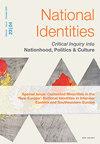“新欧洲”中有争议的少数民族:两次世界大战之间东欧和东南欧的民族认同
IF 0.7
Q3 POLITICAL SCIENCE
引用次数: 0
摘要
摘要1918年,在中欧、东欧和东南欧前帝国的领土上出现的新的或扩大的民族国家面临的诸多挑战中,很少有人像所谓的“少数民族问题”那样令人烦恼或复杂。成千上万个不同的社区突然发现,他们现在是少数民族,通常在他们指定的家园附近。作为对这一专题的介绍,本文概述了围绕两次世界大战期间地区少数民族问题的关键概念和历史辩论。它还试图挑战将这些社区定性为民族主义仇恨永久受害者的基本假设。本文章由计算机程序翻译,如有差异,请以英文原文为准。
Contested minorities in the ‘New Europe’: national identities in interwar Eastern and Southeastern Europe
ABSTRACT Among the many challenges facing the new, or enlarged, nation-states that arose on the territories of the former empires of Central, Eastern and South-Eastern Europe in 1918, few were as vexing or complex as the so-called ‘minorities question’. Thousands of disparate communities suddenly discovered that they now existed as minorities, often in areas adjacent to their designated homelands. As an introduction to this special issues, this article provides an overview of the key concepts and historical debates surrounding the interwar regional minorities question. It also seeks to challenge underlying assumptions that characterise such communities as perpetual victims of nationalist animosity.
求助全文
通过发布文献求助,成功后即可免费获取论文全文。
去求助
来源期刊

NATIONAL IDENTITIES
POLITICAL SCIENCE-
CiteScore
1.70
自引率
0.00%
发文量
37
期刊介绍:
National Identities explores the formation and expression of national identity from antiquity to the present day. It examines the role in forging identity of cultural (language, architecture, music, gender, religion, the media, sport, encounters with "the other" etc.) and political (state forms, wars, boundaries) factors, by examining how these have been shaped and changed over time. The historical significance of "nation"in political and cultural terms is considered in relationship to other important and in some cases countervailing forms of identity such as religion, region, tribe or class. The focus is on identity, rather than on contingent political forms that may express it. The journal is not prescriptive or proscriptive in its approach.
 求助内容:
求助内容: 应助结果提醒方式:
应助结果提醒方式:


